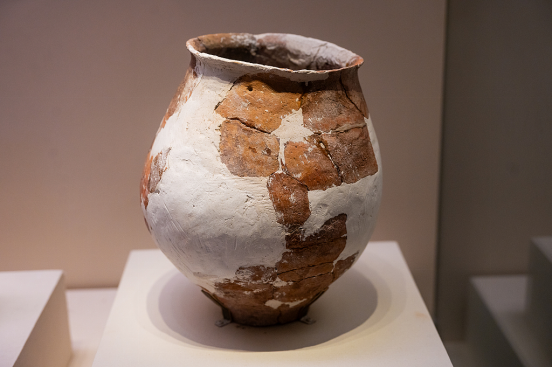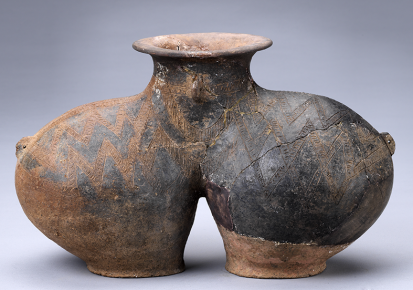Early China | The Karub site

In Tibetan language, "Karub" means "castle." It is said that during the Yuan Dynasty (1206–1368) in China, General Dorda and his troops planned to invade the Qamdo region. In defense, the local people built a fortress there (now the Karub area) to resist the invasion. After the battle ended, the fortified castle became an abandoned and dilapidated structure. In 1977, this unknown plateau village suddenly became famous because of a significant archaeological discovery—the discovery of the Karub site.
The Karub site is recognized by the archaeological and paleoanthropological communities as one of the three major primitive cultural sites in Xizang. In 2021, it was included in China's Top 100 Archaeological Discoveries of the Past Century.
Why is the Karub site defined as a culture?
The Karub site is a large-scale Neolithic site excavated for the first time in Xizang. It covers an area of over 10,000 square meters, with a remaining area of less than 5,000 square meters. It dates back approximately 4,000 years. Through three archaeological excavations in 1978, 1979, and 2002, about 8,000 stone artifacts were unearthed from the site, along with bone artifacts, pottery fragments, pottery vessels, animal bones, a large quantity of grains, and simple house structures.
The primitive culture of the Karub site features strong local characteristics. For example, the unearthed pottery consists of small flat-bottomed jars, basins, bowls, etc., without the tripod vessels commonly found in the Central Plains. The production tools include both flaked stone tools, microlith tools, and polished stone tools, with flaked stone tools being the majority. In terms of architecture, a significant number of stone materials were used to build stone-walled houses, stone-paved roads, and stone platforms. The semi-subterranean houses even featured wooden structures of "well-pole style."
Among the many Neolithic sites in China, the Karub site can be defined as a "culture" because the cultural significance it represents is different from other known types of primitive cultures in China. In the 1980s, Tong Enzheng, the late curator of the Sichuan University Museum and the main leader of the archaeological excavations at the Karub site, proposed the concept of Karub Culture, which has been widely accepted.
Double-bodied Pottery: A mark of Central Plains culture
The Karub site yielded a considerable number of pottery artifacts. However, due to the low level of productivity in the late Neolithic period on the Xizang Plateau, it is unlikely that people would have invested significant time, manpower, and resources into producing exquisite and intricately shaped pottery. Therefore, the craftsmanship and firing techniques of the unearthed pottery are generally not sophisticated, with most vessels having irregular shapes and mainly used for daily purposes such as holding water, food, and storing grains. However, amongst this collection of ordinary pottery, archaeologists have discovered a uniquely shaped and finely crafted double-bodied pottery vessel. What was its used for?

This double-bodied pottery vessel is made of fine sandy yellow clay. It has a trumpet-like flared mouth and a double-bodied shape resembling two small creatures facing each other. A pair of perforated knobs on the neck and shoulders cleverly represent the ears and tails of the animals. The surface of the pottery vessel is decorated with incised patterns and black pigments. Because it is composed of two identical bag-shaped potteries connecting to each other, it is called a "double-bodied pottery vessel." According to expert analysis, given the extremely low productivity in the prehistoric era, this vessel was not an everyday utensil, but was placed on altars as a ritual object for worship and celebration.
The diamond-shaped patterns on the double-bodied pottery vessel are distinctively painted in vermilion and ink colors, creating a strong visual impact. Such a decorative pattern of two contrastive colors is commonly seen in the Majiayao Culture, representative of prehistoric cultures in the upper reaches of the Yellow River.
Moreover, the Karub painted pattern, represented by the double-bodied pottery vessel, is directly applied on the polished surface of the sandy clay, rather than on a base layer, and the dull black pigment used is prone to flaking. This technique is similar to an early type of painted pottery from the Majiayao Culture known as the Machang. Therefore, the pottery unearthed from the Karub Culture has a possible shared origin in terms of cultural significance with the Majiayao Culture, which is considered the pinnacle of painted pottery in Neolithic China.
Stone knives: Embodiments of the diversity of the Karub Culture
The most abundant finds at the Karub site are stone tools, totaling around 8,000 pieces.
All the stone knives can be categorized into three types: single-hole, double-hole, and hole-less. The materials used are primarily sandy slate and fine sandstone, and some rare pieces made of hard jade. The stone knives are relatively flat and thin, with a typical thickness of 0.5 centimeters, and their main function was for harvesting crops. In terms of chronology, most of these stone knives belong to the early Neolithic period.
The rectangular single-hole stone knife is the predominant type among the stone knives unearthed at the Karub site, but there are also various other shapes, including crescent-shaped knives with the blades on the convex side and straight-edged knives with concave backs (also known as bird-wing stone knives). It is worth noting that many of the stone knife shapes discovered at the Karub site were first found in the southwestern region of China.
The fact that such a variety of stone knife shapes emerged relatively early in this region indicates that they were not created by the Karub Culture itself. Through the analysis of the shapes of the stone knives and the geographical features of the Karub site, it is believed that the stone knives at the Karub site were introduced from the northwest, specifically the upper and middle reaches of the Yellow River, dating back to the Longshan period, approximately 5,000 years ago.
Foxtail millet: The appearance of the Yellow River culture on the plateau
Grains were unearthed in a semi-subterranean house at the Karub site. Some of these grains were carbonized and appeared black, while others were white-gray, and there were also well-preserved non-carbonized grain husks. These grains were identified as foxtail millet (commonly known as "xiaomi" in Chinese pinyin) by experts from the Institute of Botany, Chinese Academy of Sciences.
In the third archaeological excavation of the Karub site in 2002, some crop seeds were also discovered. According to the assessment of relevant experts, they were also a type of foxtail millet.
So far, foxtail millet is the only crop variety found at the Karub site and the first crop species unearthed through archaeological excavation in Xizang. Foxtail millet has been cultivated in the Yellow River region for 8,000 years. It is highly likely that foxtail millet of the Karub Culture was introduced from the cultures such as Majiayao and became the main crop and food source for the early inhabitants in Xizang.
Sea shells: Common aesthetics
The Karub site has yielded ten perforated shell ornaments, which were the earliest "foreign goods" in prehistoric Xizang that caught people's attention. These ornaments were made from cowrie shells. They all have perforations and were found assembled with other small decorative items, suggesting that they were worn as daily adornments by the early inhabitants of Karub.
The use of cowrie shell ornaments can often be found in the Yangshao Culture, Longshan Culture, and cultures in the upper reaches of the Yellow River in Paleolithic, Mesolithic, and Neolithic ages. This seems to be a common feature of China's primitive cultures. The discovery of these shells at the Karub site not only indicates that its inhabitants shared a common cultural awareness with residents of other Neolithic cultures in China but also reflects the extensive exchange among tribes, either direct or indirect, and reaching far distances.
Many scholars used to believe that these shells originated from the South China Sea. However, based on knowledge about marine biology, the shells unearthed at the Karub site should come from the Indian Ocean. It is worth noting that, so far, no prehistoric shell ornaments have been discovered in China. Even in the early and middle stages of the Neolithic period, shell ornaments were still absent. The shells found at the Karub site, including those from the Majiayao Culture, seem to be the earliest in China. Thus, it can be inferred that the shells at the Karub site possibly came from the Indus Valley Civilization or the pre-Harappan Culture through the Pan-Himalayan corridors.
The foundation of Chinese civilization on the Xizang Plateau
The discoveries at the Karub site have filled the gap in the archaeological study of prehistoric society in Xizang and debunked the misconception that ancient Xizang was a barren, cold, and arid place and an inhabitable zone for humans.
In fact, analysis of the pollen found at the Karub site showed that the climate in the Xizang region at that time was relatively mild and humid. In certain river valleys and basins, there was abundant rainfall, lush vegetation, and thriving wildlife, providing a favorable living and subsistence environment for early humans. Therefore, the findings at the Karub site mark a fresh starting point for the study of prehistoric society in Xizang, proving with artifacts that humans have inhabited and thrived on the Xizang Plateau since ancient times.
Upon examining the Karub Culture, a more important discovery has emerged—the close relationship between the Karub Culture and the Yellow River culture.
The various artifacts unearthed at the Karub site demonstrate that the Karub Culture did not develop in isolation on the Xizang Plateau. For example, the pillar-shaped lithic cores and the slender stone flakes detached from these cores have also been found in Neolithic cultural sites in the upper reaches of the Yellow River. In addition, the polished stone tools discovered at Karub include elongated axes and adzes with a large length-to-width ratio, with their cross-sections being rectangular or squarish. These tools were also commonly found in the earlier Neolithic cultures in Gansu and Qinghai provinces in China. Among the pottery unearthed from the Karub Culture, the dominance of flat-bottomed vessels is a characteristic shared with the pottery types of the Majiayao and Banshan Machang Cultures (in Gansu and Qinghai province) in the upper reaches of the Yellow River.
What's more, the semi-subterranean houses, processed red clay walls, and living surfaces found at the Karub site also followed the traditional dwelling forms of the Majiayao Culture system. In terms of overall cultural characteristics, the Karub site shares a common cultural tradition with prehistoric cultures in the Yellow River and Yangtze River regions.
Of course, it cannot be denied that several cultural elements similar to those in South Asia and Central Asia can also be observed in the Neolithic cultures in Xizang. However, this does not change their overall cultural outlook and characteristics. It can be inferred that as representatives of the primitive cultures in the eastern fringe of the Xizang Plateau, both the Karub Culture and the primitive cultures of the upper reaches of the Yellow River are branches belonging to the same ancient southwestern cultural system in China.
The author is Shen Hongyu, an Associate Researcher at Museum of Tibetan Culture.
Liu Xian /Editor Yang Yan/Translator
Yang Xinhua /Chief Editor Liu Xian /Coordination Editor
Liu Li /Reviewer
Zhang Weiwei /Copyeditor Tan Yujie /Image Editor
The views don't necessarily reflect those of DeepChina.
